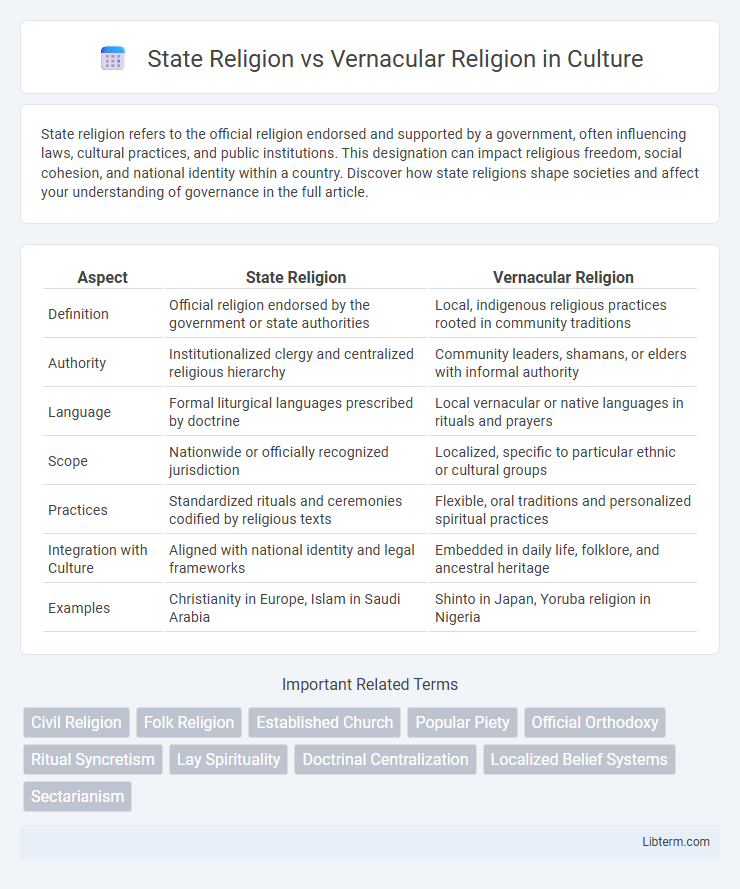State religion refers to the official religion endorsed and supported by a government, often influencing laws, cultural practices, and public institutions. This designation can impact religious freedom, social cohesion, and national identity within a country. Discover how state religions shape societies and affect your understanding of governance in the full article.
Table of Comparison
| Aspect | State Religion | Vernacular Religion |
|---|---|---|
| Definition | Official religion endorsed by the government or state authorities | Local, indigenous religious practices rooted in community traditions |
| Authority | Institutionalized clergy and centralized religious hierarchy | Community leaders, shamans, or elders with informal authority |
| Language | Formal liturgical languages prescribed by doctrine | Local vernacular or native languages in rituals and prayers |
| Scope | Nationwide or officially recognized jurisdiction | Localized, specific to particular ethnic or cultural groups |
| Practices | Standardized rituals and ceremonies codified by religious texts | Flexible, oral traditions and personalized spiritual practices |
| Integration with Culture | Aligned with national identity and legal frameworks | Embedded in daily life, folklore, and ancestral heritage |
| Examples | Christianity in Europe, Islam in Saudi Arabia | Shinto in Japan, Yoruba religion in Nigeria |
Defining State Religion and Vernacular Religion
State religion refers to the officially endorsed faith recognized and supported by a government, often integrated into national laws and institutions, shaping public policies and cultural identity. Vernacular religion, in contrast, encompasses the localized, grassroots religious practices and beliefs of ordinary people, often blending official doctrines with indigenous traditions and everyday spiritual experiences. Understanding both concepts highlights the dynamic tension between centralized religious authority and personalized, community-based expressions of faith.
Historical Evolution of State Religions
State religions historically evolved through political centralization where rulers endorsed a dominant faith to legitimize authority and unify diverse populations. This formalization contrasted with vernacular religions, which are localized, community-based belief systems reflecting indigenous customs and oral traditions. Over time, state religions institutionalized doctrine, rituals, and clerical hierarchies, often absorbing or suppressing vernacular practices to reinforce sociopolitical control.
Roots and Characteristics of Vernacular Religions
Vernacular religions originate from indigenous cultural practices and community beliefs, emphasizing localized rituals and oral traditions rather than centralized doctrines. These religions are characterized by syncretism, adaptability, and a close connection to nature and daily life, contrasting with the formal, institutionalized structures of state religions. Their roots lie in grassroots spirituality, where worship is deeply intertwined with ethnic identity, folklore, and ancestral veneration.
State Authority and Religious Control
State religion often reinforces central authority by institutionalizing specific religious practices and doctrines, thereby consolidating control over societal norms and public rituals. Vernacular religion, by contrast, comprises localized, grassroots beliefs and customs that may operate independently or even in opposition to state-imposed religious regulations. Control over religious expression highlights the tension between centralized power enforcing doctrinal uniformity and vernacular traditions preserving diverse, community-based spiritual identities.
Local Practices and Folk Beliefs
State religion often formalizes worship through centralized institutions and standardized doctrines, while vernacular religion emphasizes localized practices and deeply rooted folk beliefs unique to specific communities. Folk rituals, oral traditions, and ancestral worship commonly characterize vernacular religion, reflecting cultural identity and social cohesion at the grassroots level. These local practices frequently incorporate elements of animism, magic, and syncretism, distinguishing them from the codified rituals of state-endorsed faiths.
Tensions and Negotiations Between Official and Local Faiths
State religion often establishes formal doctrines and centralized authority, while vernacular religion reflects localized beliefs and practices rooted in community traditions. Tensions arise when official religion seeks to standardize worship, sometimes marginalizing or co-opting vernacular rituals perceived as heterodox or pagan. Negotiations between these faiths involve adaptation, syncretism, and occasional conflict, reshaping religious landscapes through cultural exchange and political power dynamics.
Case Studies: State vs Vernacular Religions Worldwide
State religions often reflect centralized power and institutionalized doctrines, exemplified by Islam in Saudi Arabia and Catholicism in Vatican City, enforcing uniform religious practices within national boundaries. Vernacular religions, such as African Traditional Religions or Indigenous beliefs in the Amazon, emphasize local customs, oral traditions, and syncretism, adapting spiritual practices to regional cultural contexts. Case studies reveal tensions and coexistence patterns, as seen in India where Hinduism is the state religion in some states but diverse tribal and folk religions persist, highlighting the complex interaction between official religious frameworks and localized faith expressions.
Impact on Identity and Community
State religion often shapes national identity by promoting a unified set of beliefs and rituals that reinforce political authority and social cohesion. Vernacular religion, rooted in local traditions and practices, fosters a strong sense of community and cultural identity by preserving unique spiritual expressions and ancestral heritage. The interaction between state and vernacular religions influences social dynamics, where state religion can marginalize vernacular practices, while vernacular religion can resist homogenization and sustain diverse communal bonds.
Modern Challenges and Syncretism
State religion systems often face modern challenges such as legal pluralism and secular governance, which complicate the imposition of a unified religious identity in diverse societies. Vernacular religions, rooted in local traditions and practices, exhibit significant syncretism by blending indigenous beliefs with global religious influences, enhancing cultural resilience and adaptability. This dynamic interplay highlights tensions between institutional authority and grassroots spirituality, underscoring the evolving nature of religious expression in contemporary contexts.
Future Trends in State and Vernacular Religions
Future trends in state religion indicate a gradual shift towards secularism as governments increasingly emphasize pluralism and human rights. Vernacular religions are likely to experience a resurgence, driven by cultural preservation efforts and the rise of localized spiritual practices adapting to modern societal values. Technological advancements and social media platforms will play a critical role in shaping and spreading vernacular religious expressions globally.
State Religion Infographic

 libterm.com
libterm.com